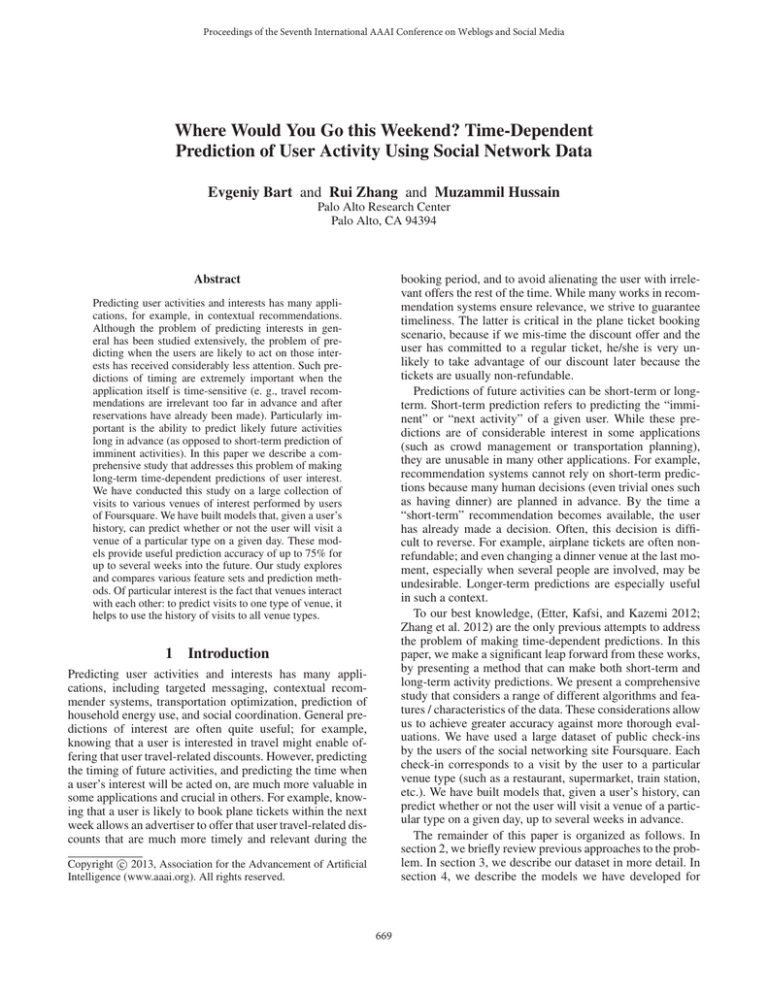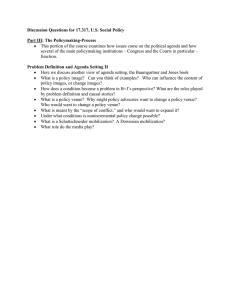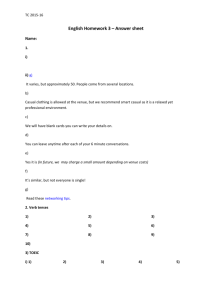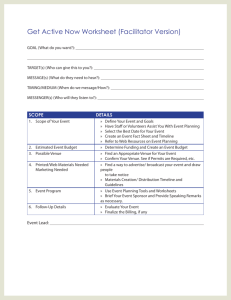
Proceedings of the Seventh International AAAI Conference on Weblogs and Social Media
Where Would You Go this Weekend? Time-Dependent
Prediction of User Activity Using Social Network Data
Evgeniy Bart and Rui Zhang and Muzammil Hussain
Palo Alto Research Center
Palo Alto, CA 94394
Abstract
booking period, and to avoid alienating the user with irrelevant offers the rest of the time. While many works in recommendation systems ensure relevance, we strive to guarantee
timeliness. The latter is critical in the plane ticket booking
scenario, because if we mis-time the discount offer and the
user has committed to a regular ticket, he/she is very unlikely to take advantage of our discount later because the
tickets are usually non-refundable.
Predictions of future activities can be short-term or longterm. Short-term prediction refers to predicting the “imminent” or “next activity” of a given user. While these predictions are of considerable interest in some applications
(such as crowd management or transportation planning),
they are unusable in many other applications. For example,
recommendation systems cannot rely on short-term predictions because many human decisions (even trivial ones such
as having dinner) are planned in advance. By the time a
“short-term” recommendation becomes available, the user
has already made a decision. Often, this decision is difficult to reverse. For example, airplane tickets are often nonrefundable; and even changing a dinner venue at the last moment, especially when several people are involved, may be
undesirable. Longer-term predictions are especially useful
in such a context.
To our best knowledge, (Etter, Kafsi, and Kazemi 2012;
Zhang et al. 2012) are the only previous attempts to address
the problem of making time-dependent predictions. In this
paper, we make a significant leap forward from these works,
by presenting a method that can make both short-term and
long-term activity predictions. We present a comprehensive
study that considers a range of different algorithms and features / characteristics of the data. These considerations allow
us to achieve greater accuracy against more thorough evaluations. We have used a large dataset of public check-ins
by the users of the social networking site Foursquare. Each
check-in corresponds to a visit by the user to a particular
venue type (such as a restaurant, supermarket, train station,
etc.). We have built models that, given a user’s history, can
predict whether or not the user will visit a venue of a particular type on a given day, up to several weeks in advance.
The remainder of this paper is organized as follows. In
section 2, we briefly review previous approaches to the problem. In section 3, we describe our dataset in more detail. In
section 4, we describe the models we have developed for
Predicting user activities and interests has many applications, for example, in contextual recommendations.
Although the problem of predicting interests in general has been studied extensively, the problem of predicting when the users are likely to act on those interests has received considerably less attention. Such predictions of timing are extremely important when the
application itself is time-sensitive (e. g., travel recommendations are irrelevant too far in advance and after
reservations have already been made). Particularly important is the ability to predict likely future activities
long in advance (as opposed to short-term prediction of
imminent activities). In this paper we describe a comprehensive study that addresses this problem of making
long-term time-dependent predictions of user interest.
We have conducted this study on a large collection of
visits to various venues of interest performed by users
of Foursquare. We have built models that, given a user’s
history, can predict whether or not the user will visit a
venue of a particular type on a given day. These models provide useful prediction accuracy of up to 75% for
up to several weeks into the future. Our study explores
and compares various feature sets and prediction methods. Of particular interest is the fact that venues interact
with each other: to predict visits to one type of venue, it
helps to use the history of visits to all venue types.
1
Introduction
Predicting user activities and interests has many applications, including targeted messaging, contextual recommender systems, transportation optimization, prediction of
household energy use, and social coordination. General predictions of interest are often quite useful; for example,
knowing that a user is interested in travel might enable offering that user travel-related discounts. However, predicting
the timing of future activities, and predicting the time when
a user’s interest will be acted on, are much more valuable in
some applications and crucial in others. For example, knowing that a user is likely to book plane tickets within the next
week allows an advertiser to offer that user travel-related discounts that are much more timely and relevant during the
c 2013, Association for the Advancement of Artificial
Copyright Intelligence (www.aaai.org). All rights reserved.
669
prediction. The performance of these models is evaluated in
section 5. We conclude in section 6.
2
The vast majority of users that publicly tweeted their
check-ins only did so a few times. For our purposes, we selected a subset of 55,000 more active users with at least 200
check-ins each.
Each check-in event consists of a unique ID, an ID of
the user who checked in and further information about the
venue, including the full name and address, latitude, longitude, and a venue type. The venue type determines the category to which the venue belongs. There are three levels of
granularity in Foursquare venue types. There are a total of
eight tier-1 venue types. These are very general categories
such as “food” or “art/entertainment”. Each tier-1 venue
type is further subdivided into several tier-2 venue types.
For example, “art/entertainment” is further subdivided into
“movie theaters”, “museums”, and several additional subtypes. Finally, each tier-2 venue type may be subdivided into
several tier-3 venue types. For example, “museums” are subdivided into “art museums”, “history museums”, and others.
There are 8 tier-1 venue types, 239 tier-2 venue types, and
348 tier-3 venue types.
Related work
Although the problem of predicting interests in general has
been studied extensively (e. g., (Marlin 2003)), the problem
of predicting when the users are likely to act on those interests has received considerably less attention.
In (Sadilek, Kautz, and Bigham 2012), the location of
Twitter users is predicted based on friends whose location
is known. However, that method is not applicable to the
cases when friendship relationships are not available. An
interesting direction for future research is to combine the
method proposed here with the method in (Sadilek, Kautz,
and Bigham 2012) for the case when both social relationships and personal visit history are available.
In (Scellato et al. 2011), sequence matching was used to
make predictions of the user’s likely next activity. In contrast, the method proposed here computes the descriptor of
the user’s history and makes predictions based on this descriptor. The two methods have complementary strengths
and weaknesses. Sequence matching is potentially more precise; however, it also has greater potential to be disturbed
by spurious events. In contrast, our descriptor-based method
makes coarser-grained predictions, but is more tolerant of
spurious events (which were a significant problem in our
dataset). In addition, a descriptor can potentially incorporate
much longer history than a literal sequence of all events. Up
to a full week of history was used in some of our experiments
(see section 5). An interesting direction for future research
is combining the descriptor-based and the sequence-based
methods.
The problem of making time-sensitive predictions has
been addressed in (Etter, Kafsi, and Kazemi 2012; Zhang
et al. 2012). However, both methods focused on predicting the “next” activity. This kind of predictors cannot be
easily used to make long-term predictions. For example,
suppose we would like to predict a user’s Friday activities on Monday. Both of the above methods would require
knowledge of all activities up to Thursday; this knowledge, however, is unavailable on Monday. The current paper extends the work in (Etter, Kafsi, and Kazemi 2012;
Zhang et al. 2012) in several ways. First, we propose a
method that allows making predictions up to several weeks
into the future, with useful accuracy. Second, we define a
much richer set of features that are used for prediction. This
allows us to improve performance by 10% (3 percentage
points) over (Zhang et al. 2012). Finally, we perform a thorough evaluation of our method on additional venue types
(see section 5).
3
4
Technical approach
We have focused on the task of predicting whether a given
user will visit a particular venue type (called the ‘target venue’) on a given date (called the ‘target date’). We
have approached this task in a classical binary classification
framework. For each user, for each venue type the user has
visited, and for each date in the time period the user was
active, a data point was constructed. The label of each data
point was +1, or “visit”, if the user visited the venue type
on that date, and −1, or “no visit” otherwise. We have used
a set of features, described below, to compute a descriptor
for every data point. This descriptor contained information
about the target date itself (such as the day of week for that
date), as well as a concise summary of the user’s history of
visits up to that date (for example, the number of days since
the last visit to a venue of the same type).
These data points were split into a training set and a test
set. The split was performed in such a manner that for every user, all data points in the test set corresponded to later
dates than the points in the training set. In other words, the
(past) history of each user’s check-ins was used to predict
the future (unseen) check-ins. This setup ensured the testing performance corresponded well to what would be obtained in a realistic application (predicting the user’s future
check-ins based on the known history to date). In particular,
one challenge in predicting future activities based on history is that users sometimes shift their activity patterns (Etter, Kafsi, and Kazemi 2012); this is accounted for in our
testing setup.
A binary classifier was trained on the training set, and
subsequently evaluated on the test set. For each classifier,
the ROC (Receiver Operating Characteristic) curve was constructed, and the Equal-Error-Rate (EER) point on that curve
was identified. EER is the point at which the false positive
rate is equal to the false negative rate. These EER values
were used to evaluate the performance of the classifiers. It
is natural to use EER to make a general-purpose evaluation
of a classifier’s performance when the exact application is
Dataset
Our dataset consists of over 180 million public check-ins by
Foursquare users. When a user checks into a location with
Foursquare, they are given the option to publicly broadcast
that check-in via Twitter. We had a Twitter filtered search set
up to listen for those tweets to collect check-ins.
670
Feature set
Target venue
Target venue + Other venues
unknown. The reason is that the relative costs of false positives and false negatives may be different in different applications. EER provides a standardized way to evaluate performance when these costs are unknown. We have ongoing
efforts that, when completed, will allow us to measure the
application-dependent costs.
tier-2
34%
33%
tier-3
34%
33%
Table 1: Prediction performance with various feature sets.
Equal error rates are shown. Lower numbers indicate better
performance. The “target venue” feature set (first row) contains just two feature types, “days since” and “day of week”.
The feature set in the second row uses features that describe
visits to other venue types in addition to the target venue
features. We have tried predicting tier-1, tier-2, and tier-3
venue type check-ins. The EER for each task is shown in
the three rightmost columns. (Corresponding accuracy values are shown in Table 2.) As can be seen, using information
from other venue types improves performance compared to
using only the information related to the target venue. This
indicates that the activities of the users are not independent,
but rather interact in various ways.
Feature sets
We have designed several types of features to perform prediction. Not all features were used for each prediction task.
Here, we describe the entire feature set. In section 5, we describe which features were used for each task. The following
features were investigated:
Day of week: the day of week for the target date. This feature helped capture the weekly cycle in the data, such as
workdays/weekends, Friday night activities, etc.
Days since: an integer specifying the number of days since
the last visit to the target venue type.
History: a set of binary (0/1) features. One feature for each
venue type was used. Note that this included all venue
types, not just the target venue type. Each feature indicated whether or not the venue type was visited on a particular day relative to the target day. Several options for
choosing this ‘history’ day were evaluated:
Feature set
Target venue
Target venue + Other venues
tier-1
72%
75%
tier-2
66%
67%
tier-3
66%
67%
Table 2: Accuracies at the EER point for various feature sets.
The format is the same as in Table 1.
today The history of the user’s visits on the target date,
excluding visits to the target venue. These features
helped capture the current user activities. The visits to
the target venue were excluded to make the prediction
task non-trivial.
N days ago The history of the user’s visits on the day N
days before the target date. These features helped capture the recent history of visits. All venue types were
used since excluding the target venue was no longer
necessary.
5
tier-1
28%
25%
An interesting direction for future research is to describe
the ways in which these interactions occur. Of particular interest is the idea that a higher-level concept may underlie
several related check-ins. For example, check-ins at a transportation venue, an office, a restaurant, and another transportation venue might correspond to a concept of “a workday in an office”, while several check-ins at bars and restaurants on a Friday night might correspond to a concept of
a “pub crawl”. Automatically discovering such higher-level
concepts is a subject of future research.
Results
We have compared several types of classifiers on the prediction task outlined above. The classifiers we compared were
logistic regression, Naive Bayes, SVM, mixture of logistic
regressions and mixture of Naive Bayes models. No significant differences were observed between these classifiers;
therefore, we only report logistic regression results unless
indicated otherwise.
The accuracy at the EER point is, of course, 100% – EER.
These accuracy values are shown in Table 2. It is desirable
to report accuracy values at the EER point, especially for
unbalanced datasets. For example, for tier-3 venues, only 2–
8% of the days included any visits. As a result, a method that
always predicts “no visit” will achieve over 90% overall accuracy. This number is inconvenient to work with, however,
because it is composed of 100% accuracy on negative examples and 0% accuracy on positive examples. In contrast,
X% accuracy at EER always corresponds to X% correct on
positive examples and X% correct on negative examples.
Venue interactions
In Table 1, we show the performance of different feature
sets on the prediction task. The baseline feature set contains just two feature types, “days since” and “day of week”.
This baseline corresponds to the method used in (Zhang et
al. 2012). The proposed method achieves useful prediction
accuracy using just these features. However, note that the
performance of the method improves by about 10% (3 percentage points) when features that describe visits to other
venue types are added. This improvement indicates that the
visits to different venues are not independent, but rather interact in various ways.
It is also of interest to compare the performance to the
method used in (Zhang et al. 2012). However, the accuracy
results in (Zhang et al. 2012) were not reported at the EER
point; therefore, they are not directly comparable to the results in Table 2. We have computed the accuracy of our
method at the ROC point used in (Zhang et al. 2012). Our accuracy is 87% correct, compared to 76% correct for (Zhang
et al. 2012)).
671
0.35
0.25
EER
0.45
ing predictions an integer number of weeks into the future.
The reason is that users’ activities exhibit strong week-based
seasonality, and it is advantageous to use past data from
the same day of week in addition to the more recent data.
The solid line in Figure 1 shows the prediction performance
based on two types of history features: the features for N
days earlier than the target date (same features as those used
for the dashed line), as well as history features for the latest
date, older than N days, that is the same day of week as the
target date. Note again that both types of history features are
at least N days old and can therefore be used for predicting
N days into the future. As can be seen, this combination improves performance considerably over the previous method.
0
5
10
20
30
6
Conclusions
We have presented a method for predicting the timing of
user activity. The motivation behind the method is that while
knowing the general set of interests of a customer is useful, knowing the time when the custormer is likely to act on
those interests is even more valuable in a variety of applications. The method we presented was evaluated on a large
database of Foursquare check-ins. We have shown that the
proposed method can achieve useful accuracy (up to 75%
correct at EER) and predict the timing of activities up to several weeks into the future. An intriguing observation is that
check-ins to different venue types are not independent, but
rather interact in various ways. Exploiting these interactions
allows the method to significantly improve the prediction accuracy.
Number of days into future
Figure 1: Prediction performance as function of the time
horizon. Y axis: equal error rate (lower numbers indicate
better performance). X axis: the number of days into the future the prediction is being made. Dashed line: prediction
using “day of week” and N -day old history features. Solid
line: prediction using “day of week”, N -day old history features, and N -day old history features for the same day of
week as target date. Dotted horizontal line: EER with only
the “day of week” feature; this can be thought of as asymptotic EER of predicting infinitely far into the future (when
history features become irrelevant).
References
Etter, V.; Kafsi, M.; and Kazemi, E. 2012. Been there, done
that: What your mobility traces reveal about your behavior.
In Mobile Data Challenge 2012 Workshop at Pervasive.
Marlin, B. 2003. Modeling user rating profiles for collaborative filtering. In NIPS.
Sadilek, A.; Kautz, H.; and Bigham, J. P. 2012. Finding your
friends and following them to where you are. In Proceedings
of the fifth ACM international conference on Web search and
data mining, 723–732.
Scellato, S.; Musolesi, M.; Mascolo, C.; Latora, V.; and
Campbell, A. T. 2011. NextPlace: A spatio-temporal prediction framework for pervasive systems. In Pervasive.
Zhang, R.; Price, B.; Chu, M.; and Walendowski, A. 2012.
Location-based predictions for personalized contextual services using social network data. In AwareCast workshop in
conjunction with Pervasive 2012.
Predicting future activities
The performance figures reported in Table 1 describe shortterm prediction performance (i. e., predicting the action today based on recent history). Predicting activities further
out in the future is of considerable interest in many applications (such as optimizing the timing of discount offers). The
method proposed here can be readily applied to this problem.
The only necessary modification is omitting the feature
“Days since”, because its value is unknown when making
predictions for any day other than today. For example, if
on February 11th we’d like to make a prediction for visits
on February 15th, computing the value of “Days since” for
February 15th requires knowing whether there was a visit on
any of the dates from 12th through 14th; these, however, are
unknown on February 11th.
We have applied the method proposed here to predicting
user visits N days into the future. We have used the “Day
of week” feature (since it can be computed for an arbitrary
future date), as well as the “history” features for N days
earlier than the target date.
The performance of the method is shown in Figure 1
(dashed line). As expected, the performance decreases when
trying to predict events further in the future, but remains useful for up to several weeks. Note also the strong weekly
seasonality: the error rate drops considerably when mak-
672




